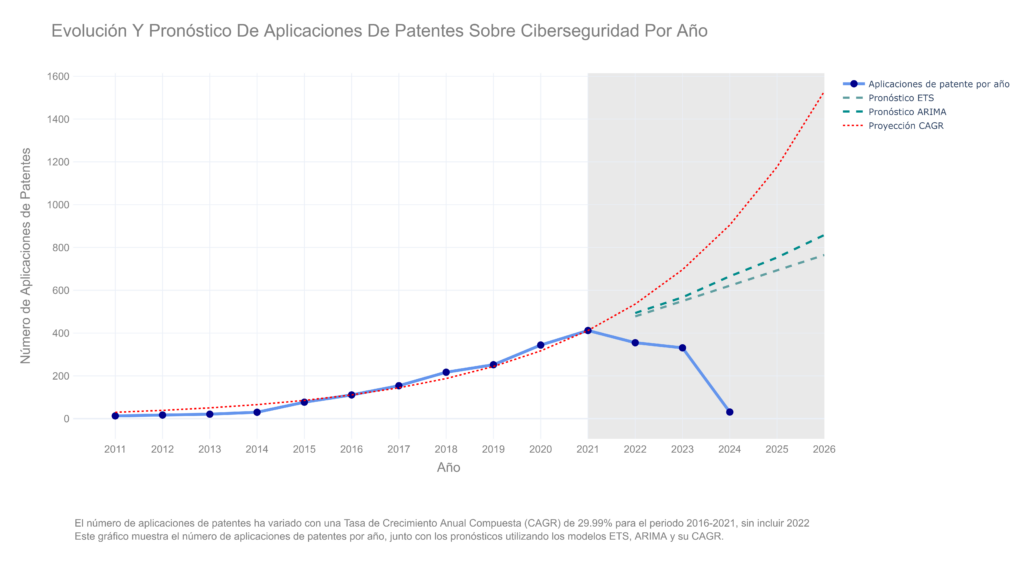
Cybersecurity has emerged as a fundamental pillar in the protection of data and infrastructure in the digital age. Increasing global interconnectedness has left individuals and organizations vulnerable to increasingly complex cyber threats, the consequences of which can range from the disruption of Internet access to the leaking and manipulation of critical information. The costs of data breaches due to cybersecurity breaches have increased by 15% between 2020 and 2023, according to a global report. Latin America is not immune to these risks, with economic losses that will reach $3.69 million in 2023.
In this context, technological surveillance and the production of cybersecurity patents are essential to identify and anticipate emerging threats, as well as closely follow innovations in the field. On the other hand, the production of patents encourages the creation of novel and effective solutions, ensuring robust and adaptable protection against the constant advances of cyber threats. Together, these activities not only strengthen defense against cyberattacks, but also drive technological progress and competitiveness in the field of cybersecurity.
Evolution of patents and technological trends

The evolution of patents in the cybersecurity space reveals an interesting story of how our understanding and response to cyber risks have evolved over time. Initially, when digital technology emerged the record of innovations in cybersecurity was limited. Awareness of cyber risks was nascent and patenting activity was relatively low. However, as cyber threats became evident and the repercussions became more tangible, cybersecurity patenting activity intensified.
In particular, in the last eight years, there has been a significant increase in the number of patents related to cybersecurity. It is relevant to highlight that the average patent assignment time is approximately 2.4 years, which implies that trends in applications and approvals are reflected from approximately 2022 onwards.
The outlook and forecast indicate sustained growth in patent applications in the coming years. This forecast is based on trends identified through analysis of patent data, suggesting a period of continued growth in the state of cybersecurity technology. This increase in patenting activity reflects not only greater recognition of the strategic importance of cybersecurity, but also a proactive response to address emerging challenges in cyberspace.
In summary, the evolution of patents in the field of cybersecurity not only reflects technological advancement, but also an adaptive and forward-looking response to cyber risks. This trend underscores the critical importance of cybersecurity innovation to protect digital infrastructures and safeguard trust in the interconnected world we live in.
Geographic distribution of patents and main developing institutions
The geographic distribution of cybersecurity-related patents reflects significant leadership by the United States, closely followed by China and India. First of all, the United States, as the epicenter of global technological innovation, leads the registration of patents. The United States has sought to be at the technological forefront, which is reflected in its leadership in granting patents related to cybersecurity.
China has emerged because the Chinese government has prioritized investment in research and development in this field, promoting both internal innovation and the acquisition of technologies. India has demonstrated remarkable technological advancement in cybersecurity, evidenced by the strong growth in patent applications in recent years. The United States, China and India lead the way in terms of number of patents, each with their own approach and strategy to address cybersecurity challenges in the 21st century. This collective leadership underscores the global importance of protecting our digital infrastructures and safeguarding trust in cyberspace.
Commercial valuation of the segments
The commercial valuation of patents applied to cybersecurity reflects the diversity of innovative technologies and solutions in this field. While most patents have an estimated value of less than $300,000, this value range should not be underestimated, as many of these technologies represent significant advances in data protection and digital security.
The commercial valuation of a patent depends on its technical innovation, its market viability, and its ability to address current cybersecurity needs and challenges. The continued growth in this sector and positive projections for the future suggest that the value of these technologies in the market is increasing. As awareness of cyber risks continues to rise and privacy and security regulations become stricter, demand for innovative cybersecurity solutions is expected to continue to grow.
Conclusions
Technological surveillance in cybersecurity reveals a dynamic and constantly evolving panorama. The United States, China and India lead innovation in this field, reflecting growing interest and activity globally. As awareness of cyber risks increases, so does investment in innovative cybersecurity solutions. It is crucial that institutions and organizations recognize the strategic importance of cybersecurity and dedicate significant resources to the development and implementation of effective solutions. Collaboration between companies, governments, academic institutions and other relevant actors is essential to address constantly evolving cyber threats.



